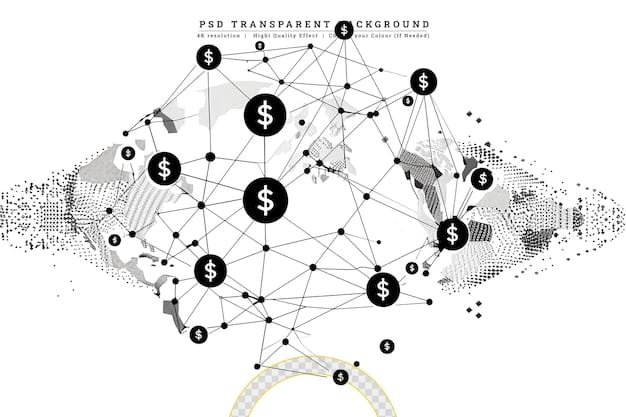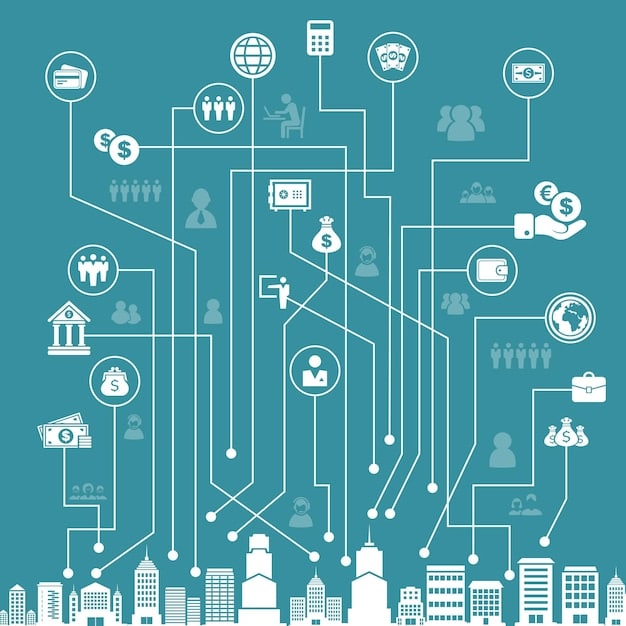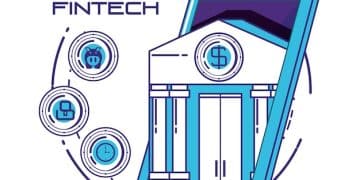Open Banking APIs to Redefine US Personal Finance by 2025

By 2025, open banking APIs will revolutionize US personal finance management by fostering unprecedented data sharing, enabling hyper-personalized financial tools, and empowering consumers with greater control over their financial data, transforming how Americans interact with their money.
The financial landscape is in constant flux, driven by technological advancements and evolving consumer expectations. A significant shift gaining momentum is the rise of open banking, a paradigm where financial institutions securely share customer data with third-party providers via Application Programming Interfaces (APIs). This evolution promises to fundamentally alter how we manage our money. The question of how will open banking APIs redefine personal finance management in the US by 2025? is not merely academic; it’s a critical inquiry into the future of financial empowerment and innovation.
The Foundation of Open Banking: Understanding the API Revolution
At its core, open banking relies on APIs—software intermediaries that allow different applications to talk to each other. For the financial sector, this means a bank’s system can securely communicate with a third-party app, sharing customer-approved data like transaction history or account balances. This process moves beyond traditional data-sharing methods, which were often cumbersome and less secure, paving the way for a more integrated and dynamic financial ecosystem. The revolution lies in standardization and consent-driven access.
Unlike screen scraping, a less secure and often unreliable method of data aggregation, API-led open banking ensures data is shared in a structured, secure, and permissioned manner. This shift empowers consumers by putting them in control of their financial data, deciding who gets to see it and for what purpose. This foundational change is critical for building trust and enabling innovative services that truly benefit the end-user.
Enhanced Security and Consumer Control
One of the primary concerns with data sharing is security. Open banking APIs are built with robust security protocols, often employing advanced encryption and authentication methods to protect sensitive financial information. Regulators in various markets, including increasingly in the US, are pushing for standards that prioritize consumer protection and data privacy. This framework ensures that while data flows more freely, it does so within a safeguarded environment.
- Consent-driven Access: Users explicitly grant and revoke permissions for data sharing.
- Advanced Encryption: Data is encrypted both in transit and at rest, minimizing interception risks.
- Standardized Protocols: APIs adhere to strict technical and security specifications, ensuring reliability.
The shift towards a consent-based model is transformative. It moves consumers from a passive role to an active participant in their financial data’s journey. This control is not just about security; it’s about empowerment, enabling individuals to leverage their data for better financial outcomes.
Moreover, the regulatory landscape in the US, while still evolving compared to regions like the UK or EU, is gradually embracing principles that align with open banking. Initiatives like Section 1033 of the Dodd-Frank Act provide a legal underpinning for consumer data rights, suggesting a future where data portability and access are not just optional extras but fundamental expectations. This regulatory push will accelerate the adoption and refinement of open banking APIs across the US financial sector.
Personalized Financial Tools: Tailoring Experiences to Individual Needs
With open banking, the traditional rigid boundaries of financial services begin to blur. Instead of disparate accounts and limited tools, consumers can anticipate a unified and highly personalized financial experience. This personalization extends beyond simple budgeting apps, delving into proactive advice, automated savings, and tailored product recommendations, all powered by a comprehensive view of an individual’s financial health.
Imagine an application that, with your permission, analyzes your spending habits across multiple accounts, identifies recurring subscriptions you might have forgotten, and even suggests better deals on utilities based on your usage patterns. This level of insight becomes possible when your financial data, securely aggregated through APIs, can be analyzed by intelligent algorithms.
Hyper-Customized Budgeting and Spending Management
The days of manual spreadsheet budgeting are quickly fading. Open banking APIs enable apps to automatically categorize transactions from all your linked accounts in real-time. This not only provides an accurate picture of your finances but also allows for predictive analytics that can alert you to potential overspending or opportunities to save. Budgets become dynamic, adapting to your income and expenditure patterns rather than relying on static estimations.
Consider an app that learns your spending patterns and automatically allocates funds to different savings goals, or one that detects when you are close to an overdraft limit and offers a short-term, low-interest loan from a preferred provider. These are not futuristic fantasies but capabilities rapidly becoming reality through open banking infrastructure. The customization ensures that the tool works for the user, rather than the user working for the tool.
- Automated Categorization: Transactions from various banks are automatically classified for easy tracking.
- Predictive Analytics: Algorithms identify spending trends and forecast future financial positions.
- Real-time Alerts: Notifications for unusual activity, approaching limits, or savings opportunities.

The intelligence embedded within these new tools won’t just reflect past behavior. They will leverage machine learning to anticipate future financial needs and offer timely, relevant advice. For example, if an app observes a consistent pattern of medical expenses, it might suggest reviewing health insurance policies or setting up a dedicated healthcare savings fund. This shift from reactive to proactive financial management is a cornerstone of the open banking revolution.
Democratizing Access to Financial Services: A New Era of Inclusivity
One of the most profound impacts of open banking APIs will be on financial inclusion, particularly for underserved populations in the US. Traditional financial systems often present barriers to entry, such as stringent credit checks or minimum balance requirements, which can exclude a significant portion of the population. Open banking offers a pathway around these hurdles by allowing individuals to leverage their own data to build financial profiles and access services previously out of reach.
For small businesses and freelancers, for instance, access to credit can be a major challenge. With open banking, lenders can gain a more holistic view of an applicant’s financial health—beyond just a credit score—by analyzing real-time cash flow and transaction data. This enables more accurate risk assessments and potentially broader access to capital.
Innovative Products for the Unbanked and Underbanked
The unbanked and underbanked populations often rely on costly alternative financial services like payday loans or check-cashing services. Open banking can facilitate the creation of innovative, lower-cost products tailored to their specific needs. By analyzing their income streams and spending patterns, fintechs can offer micro-loans, flexible savings accounts, or even personalized financial literacy tools that traditional banks might not provide.
These new services can integrate seamlessly into daily life, making financial management less daunting and more accessible. Imagine an app that allows a user to build a credit history based on regular utility payments, or one that connects them with affordable banking services that understand their unique financial rhythms. The potential for open banking to bridge existing financial divides is immense, fostering greater equity within the system.
- Alternative Credit Scoring: Using real-time transaction data to assess creditworthiness beyond traditional scores.
- Bespoke Financial Products: Services designed specifically for the financial habits of underserved communities.
- Lower Barrier to Entry: Reducing or removing requirements that typically exclude certain populations from mainstream finance.
The challenge will be to ensure that these new services are genuinely beneficial and not simply new ways to extract fees from vulnerable populations. Regulatory oversight and a commitment to ethical AI and data practices will be crucial in ensuring that the democratizing potential of open banking is fully realized. The goal is not just access, but access to fair and beneficial financial opportunities.
Enhanced Competition and Innovation in the Financial Sector
Open banking fundamentally disrupts the traditional banking model where incumbent financial institutions held proprietary control over customer data. By opening up secure access to data via APIs, it levels the playing field significantly. This increased access encourages a surge in competition, as fintech startups and established technology companies can now build innovative financial products and services without needing to own the underlying banking infrastructure. The consumer becomes the ultimate beneficiary of this competitive environment.
New entrants, unencumbered by legacy systems, can rapidly iterate and deploy solutions that cater to niche markets or address specific pain points that traditional banks have overlooked. This agility, coupled with data-driven insights through open APIs, fuels a wave of innovation that pushes the entire industry forward. Banks, in turn, are compelled to innovate more rapidly to retain their customer base, either by developing their own open banking solutions or by partnering with fintechs.
Collaborative Ecosystems and Fintech Dominance
The future of finance in the US will likely be characterized by a collaborative ecosystem rather than pure competition. Banks and fintechs will find mutual benefit in partnerships, where banks provide the robust infrastructure and regulatory compliance, and fintechs offer agile innovation and specialized user experiences. This synergy can lead to superior products and services that combine the best of both worlds. We will see more “Banking-as-a-Service” (BaaS) models emerging, where banks essentially license their core functionalities through APIs to other providers.
Fintech firms, through their mastery of technology and focus on user experience, are uniquely positioned to leverage open banking APIs. They can aggregate services from multiple providers into a single, intuitive interface, providing a marketplace for financial products. This aggregation significantly enhances convenience for consumers who no longer need to manage multiple apps or websites for different financial needs. This shift signifies a move from product-centric to customer-centric financial services.
- New Business Models: Emergence of BaaS and financial marketplaces.
- Accelerated Product Development: Faster iteration and deployment of new financial tools.
- Strategic Partnerships: Increased collaboration between traditional banks and fintech disruptors.
This dynamic environment is not without its challenges. Data privacy regulations, interoperability standards, and maintaining consumer trust will remain paramount. However, the overall trend points towards a more vibrant and competitive financial landscape, driven by the open exchange of information and a relentless pursuit of better customer experiences. By 2025, it’s expected that fintechs will have considerably broadened their reach and influence within the US personal finance sector, significantly leveraging open banking.
Challenges and Regulatory Landscape Adoption in the US
While the promise of open banking is immense, its full realization in the US by 2025 faces several significant hurdles, chief among them being the complex and fragmented regulatory landscape. Unlike the UK and EU, which have specific open banking mandates (PSD2 and Open Banking UK), the US lacks a single, overarching federal framework. This absence leads to a patchwork approach, relying instead on a combination of consumer protection laws, state-level initiatives, and voluntary industry standards. This creates uncertainty and can slow down adoption.
Another major challenge is establishing trust among consumers and financial institutions. Consumers need assurance that their data is secure and that they maintain control over it, while financial institutions need clear guidelines and incentives to invest in API development and embrace data-sharing paradigms. Convincing entrenched institutions to open up their systems requires more than just technological capability; it demands a cultural shift and a clear articulation of mutual benefits.
Overcoming Data Standardization and Interoperability Issues
The lack of uniform data standards across the myriad of financial institutions in the US poses a significant technical challenge. For open banking APIs to work seamlessly, there needs to be a common language or framework for how financial data is structured and exchanged. Without this, fintechs face the daunting task of integrating with diverse and often proprietary systems, increasing development costs and complexity. Initiatives like the Financial Data Exchange (FDX) are attempting to address this, but widespread adoption takes time.
Interoperability is also key. It’s not enough for banks to simply offer APIs; these APIs must be able to communicate effectively with a wide range of third-party applications. This requires a collaborative effort from industry players to agree on technical specifications and best practices. The transition from legacy systems, which many traditional banks rely on, to modern API-driven architectures is a monumental undertaking, requiring substantial investment in both technology and talent.
- Regulatory Ambiguity: Lack of a unified federal open banking mandate creates fragmentation.
- Data Standardization: Need for common data formats and protocols across institutions.
- Trust and Adoption: Building confidence among consumers and financial entities to embrace data sharing.

Educating consumers about the benefits and risks of open banking is also crucial. Many Americans are understandably wary of sharing financial data, especially given past data breaches. Clear communication about security measures, data usage policies, and consumer rights will be essential to foster broad-based adoption. Without consumer buy-in, the most sophisticated open banking infrastructure will fail to achieve its potential, even by 2025.
The Future Vision: Proactive, Integrated, and Intelligent Finance
By 2025, the vision for personal finance management in the US, powered by open banking APIs, is one of unparalleled proactivity, seamless integration, and intelligent automation. Gone will be the days of reactive financial decisions and siloed accounts. Instead, consumers can anticipate a financial ecosystem that understands their needs, anticipates their challenges, and empowers them to achieve their goals with minimal effort.
This future extends beyond mere financial transactions. It envisions a world where your financial data can seamlessly integrate with aspects of your daily life, from personalized shopping recommendations based on your spending habits to automated investment adjustments linked to your long-term goals. The focus shifts from managing money to optimizing your financial life as a whole, always with consumer consent at the forefront.
Automated Financial Wellness and Goal Achievement
Open banking will enable a new generation of financial wellness tools that actively work towards your goals. Imagine an app that not only helps you save for a down payment on a house but also automatically optimizes your investments based on market conditions, directly drawing funds from your checking account as specified. This level of automation significantly reduces the cognitive load associated with financial management, making it accessible to a broader audience.
These intelligent systems can also provide real-time, personalized financial coaching. If you consistently overspend in a particular category, the system could offer immediate advice or suggest alternative spending patterns. If an unexpected expense arises, it might automatically rebalance your budget or suggest drawing from an emergency fund, always within parameters you’ve set. The goal is to make managing personal finances feel less like a chore and more like having a dedicated, intelligent financial advisor at your fingertips.
- Holistic Financial Views: Consolidated data from all financial accounts for a complete picture.
- Intelligent Automation: AI-driven processes for savings, investments, and debt management.
- Proactive Advice: Personalized recommendations and alerts based on individual financial patterns.
The transformation promises to be profound, moving from a system where individuals manage their money reactively to one where their money actively works for them, guided by smart technology and secure data exchange. This paradigm shift will not only redefine personal finance management but also fundamentally alter the relationship between consumers and their financial institutions, leading to a more engaged, informed, and empowered financial journey for every American by 2025.
| Key Aspect | Brief Description |
|---|---|
| 🚀 Enhanced Personalization | APIs enable highly customized financial tools and advice based on comprehensive data. |
| 🔒 Data Security & Control | Consumers gain unprecedented control over data sharing with robust security protocols. |
| 📈 Increased Competition | Open banking fosters innovation and new services from fintech and traditional banks. |
| 🤝 Financial Inclusion | New avenues for underserved populations to access affordable and tailored financial services. |
Frequently Asked Questions About Open Banking and Personal Finance by 2025
Open banking APIs are secure technical interfaces that allow banks to share customer-approved financial data with third-party applications and services. They standardize how financial information is exchanged, enabling the creation of new, integrated financial products while ensuring user consent and data security. By 2025, they will be central to how US consumers manage their personal finances.
Open banking will offer significant benefits, including more personalized financial advice, automated budgeting tools, and access to a wider array of financial products. You’ll gain a holistic view of your finances across different institutions, potentially leading to better savings, smarter investments, and more efficient debt management, all tailored to your specific financial situation by 2025.
Yes, security is a paramount concern with open banking. APIs employ advanced encryption and strong authentication protocols to protect your data. Critically, you have explicit control over which data is shared and with whom, and you can revoke access at any time. Regulatory oversight is also evolving to ensure robust consumer protection and data privacy standards are met by 2025.
Absolutely. Traditional banks will continue to play a crucial role, often by partnering with fintech companies to leverage open banking APIs. They may focus on providing the core infrastructure and regulatory compliance, while fintechs specialize in creating innovative, user-friendly applications that sit on top of these banking services. This collaboration creates a more dynamic and competitive financial ecosystem for US consumers.
The main challenges in the US include a fragmented regulatory landscape, requiring a unified federal approach to data sharing. Additionally, achieving data standardization across diverse financial institutions and building ubiquitous consumer trust in sharing financial data securely are significant hurdles. Overcoming these will be crucial for open banking to reach its full potential by 2025.
Conclusion
The trajectory of open banking APIs in the US by 2025 points toward an undeniable transformation of personal finance management. From empowering consumers with granular control over their data to fostering a new generation of hyper-personalized and proactive financial tools, the impacts are set to redefine our relationship with money. While regulatory challenges and the need for standardized adoption remain, the momentum towards a more integrated, intelligent, and inclusive financial ecosystem is clear. Open banking is not merely an incremental change; it’s a paradigm shift that promises to place financial wellness firmly within the grasp of every American, creating a landscape of unprecedented innovation and choice.





